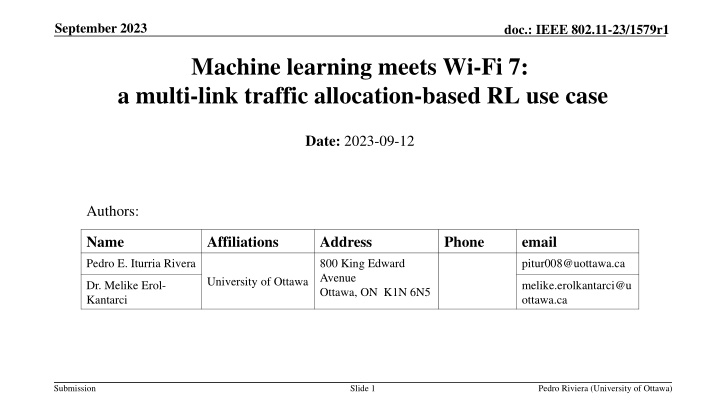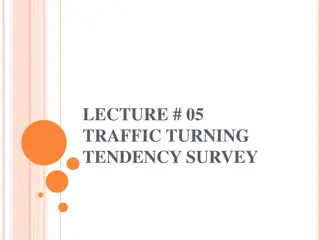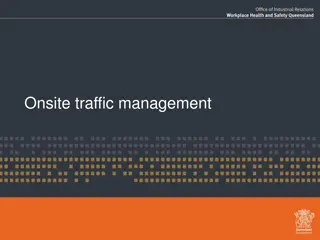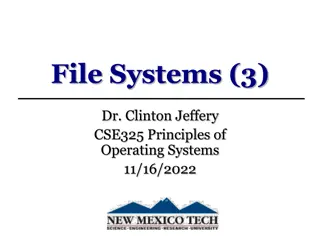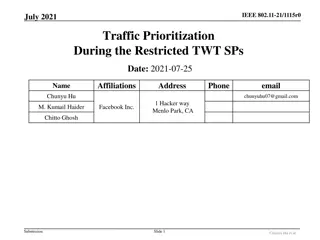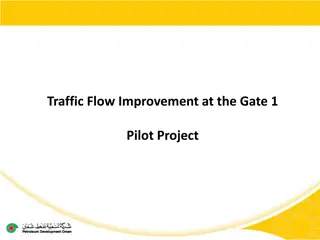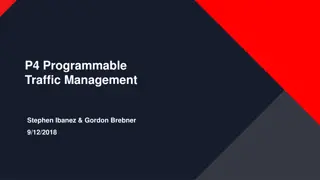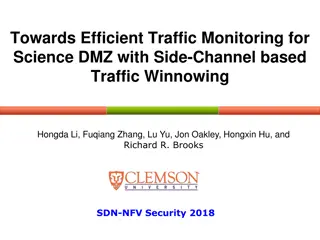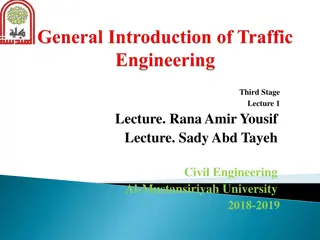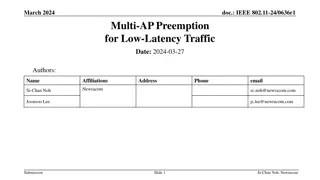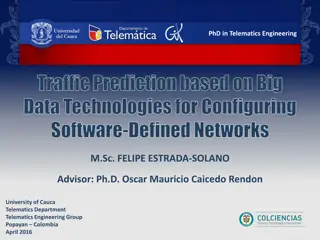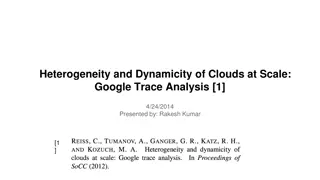Machine Learning Meets Wi-Fi 7: Multi-Link Traffic Allocation-Based RL Use Case
The paper discusses the application of a Reinforcement Learning algorithm, Multi-Headed Recurrent Soft-Actor Critic, for optimizing traffic allocation in IEEE 802.11be Multi-Link Operation networks. This work aims to enhance throughput and reduce latency in MLO-capable devices by distributing incoming traffic efficiently among available interfaces using MH-RSAC. The study focuses on the system model, state and action space selection, reward function, and performance evaluation through simulation results, culminating in valuable insights for future network optimization strategies.
Download Presentation

Please find below an Image/Link to download the presentation.
The content on the website is provided AS IS for your information and personal use only. It may not be sold, licensed, or shared on other websites without obtaining consent from the author.If you encounter any issues during the download, it is possible that the publisher has removed the file from their server.
You are allowed to download the files provided on this website for personal or commercial use, subject to the condition that they are used lawfully. All files are the property of their respective owners.
The content on the website is provided AS IS for your information and personal use only. It may not be sold, licensed, or shared on other websites without obtaining consent from the author.
E N D
Presentation Transcript
September 2023 doc.: IEEE 802.11-23/1579r1 Machine learning meets Wi-Fi 7: a multi-link traffic allocation-based RL use case Date: 2023-09-12 Authors: Name Affiliations Address Phone email Pedro E. Iturria Rivera 800 King Edward Avenue Ottawa, ON K1N 6N5 pitur008@uottawa.ca University of Ottawa Dr. Melike Erol- Kantarci melike.erolkantarci@u ottawa.ca Submission Slide 1 Pedro Riviera (University of Ottawa)
September 2023 doc.: IEEE 802.11-23/1579r1 Overview This presentation will be comprised by: RL meets Multi-Link Operation in IEEE 802.11be: Multi-Headed Recurrent Soft-Actor Critic-based Traffic Allocation Motivation. Overview of the Multi-Headed Recurrent Soft-Actor Critic. System Model. Multi-Headed Recurrent Soft-Actor Critic Dealing with Non-Markovian environments in RL. State Space Selection. Action Space Selection. Reward Function. Traffic Considerations Performance Evaluation Simulation Results Conclusions Submission Pedro Riviera (University of Ottawa)
September 2023 doc.: IEEE 802.11-23/1579r1 *Accepted in IEEE International Conference of Communications (ICC) 2023, Rome, Italy Submission Pedro Riviera (University of Ottawa)
September 2023 doc.: IEEE 802.11-23/1579r1 Motivation IEEE 802.11be Extremely High Throughput , commercially known as Wireless-Fidelity (Wi-Fi) 7 is the newest IEEE 802.11 amendment that comes to address the increasingly throughput hungry services such as Ultra High Definition (4K/8K) Video and Virtual/Augmented Reality (VR/AR). To do so, IEEE 802.11be presents a set of novel features that will boost the Wi-Fi technology to its edge. To achieve superior throughput and very low latency, a careful design approach must be taken, on how the incoming traffic is distributed in MLO capable devices. In this paper, we present a Reinforcement Learning (RL) algorithm named Multi-Headed Recurrent Soft- Actor Critic (MH-RSAC) to distribute incoming traffic in 802.11be MLO capable networks. Submission Pedro Riviera (University of Ottawa)
September 2023 doc.: IEEE 802.11-23/1579r1 Overview of MH-RSAC In this work, we focus our interest on MLO in 802.11be. Specifically, MLO allows Multi-Link Devices (MLD)s to concurrently use their available interfaces for multi-link communications. In this context, we intend to optimize the traffic allocation policy over the available interfaces with the aid of Reinforcement Learning (RL). Submission Pedro Riviera (University of Ottawa)
September 2023 doc.: IEEE 802.11-23/1579r1 System Model In this work, we utilize an IEEE 802.11be network with a predefined set of M APs and N stations attached per AP. In addition, we consider all APs to be MLO-capable with a number of available interfaces ??= 3 whereas in the case of the stations the MLO capability can vary. This design decision is taken based on the fact that single device and multi-device terminals will coexist in real scenarios due to terminal manufacturer diversity. Furthermore, stations are positioned in two ways with respect their attached AP: 80% of the users are positioned randomly in a radius r [1 8] m and the rest with a radius r [1 3] m. All APs and stations support up to a maximum of 16-SU multiple-input multiple-output (MIMO) spatial streams. IEEE P802.11, TGax Simulation Scenarios, IEEE, Tech. Rep., 2015. [Online]. Available: https://mentor.ieee.org/802.11/dcn/ 14/11-14-0980-16-00ax-simulation-scenarios.docx Submission Pedro Riviera (University of Ottawa)
September 2023 doc.: IEEE 802.11-23/1579r1 Multi-Headed Soft-Actor Critic The SAC agent introduced initially in [2] is a maximum entropy, model-free and off-policy actor-critic method: 1. Relays on the inclusion of a policy entropy term into the reward function to encourage exploration. 2. It reutilizes the successful experience of the minimum operator in the selection of the double Q-Functions that comprise the critic. In addition to the previous considerations, we include: 1. Substitute the minimum operator by an average operator that allowed to reduce the bias of the lower bound of the double critics [10]. 2. Modify the structure of the critic and the actor of the discrete SAC to allow multi-output. [2] T. Haarnoja, A. Zhou, P. Abbeel, and S. Levine, Soft actor-critic: Off policy maximum entropy deep reinforcement learning with a stochastic actor, in 35th International Conference on Machine Learning (ICML), 2018. [10] H. Zhou, Z. Lin, J. Li, D. Ye, Q. Fu, and W. Yang, Revisiting Discrete Soft Actor-Critic, 2022. [Online]. Available: https://arxiv.org/abs/2209. Submission Pedro Riviera (University of Ottawa)
September 2023 doc.: IEEE 802.11-23/1579r1 Dealing with Non-Markovian environments in RL Reinforcement Learning faces some challenges when dealing with non-Markovian environments. The reason is that RL main goal is to maximize the reward given a certain state and action as: When the previous relationship is not fulfilled due partial observability of the Markovian state, the observation state should include more that one input and utilize a portion of the interaction history. Submission Pedro Riviera (University of Ottawa)
September 2023 doc.: IEEE 802.11-23/1579r1 State Space Selection The environment is modeled as a Partially Observable Markov Decision Process (POMDP), thus a sequence of the observation space is considered instead one instance. The action space is defined as: Furthermore, we define ?? and ??? ,respectively as: where ?? corresponds to the number stations receiving traffic flows and ?? the number of stations attached to the corresponding AP. Submission Pedro Riviera (University of Ottawa)
September 2023 doc.: IEEE 802.11-23/1579r1 Action Space Selection As discussed, the MH-RSAC structure is comprised by two heads: one providing the action output when two interfaces are available and another for the case when three are. Thus, the action space can be defined as: Where ??= {1,2,3} refers to the fraction of the total flow traffic to be allocated to each available interface. Consequently, the action space size of each head is calculated as the number of permutations of the possible fractions that sum to one. Submission Pedro Riviera (University of Ottawa)
September 2023 doc.: IEEE 802.11-23/1579r1 Reward function The reward function can be defined as: ??? corresponds to the average call drop observed by the ?? AP. In addition, we scale the reward to where ?? [ 1, 1]. Reward function with hindsight where ????corresponds to a hindsight reward based on baselines results or on expert knowledge. Submission Pedro Riviera (University of Ottawa)
doc.: IEEE 802.11-23/1579r1 Traffic Considerations In this work, we utilize a VR cloud server model and derive the Cumulative Distribution Functions (CDF) to be utilized as one of our simulation traffic flows. The derivation of the inverse of the CDF for the frame inter-arrival time and frame size is described below: Submission Pedro Riviera (University of Ottawa)
September 2023 doc.: IEEE 802.11-23/1579r1 Performance Evaluation Simulations are performed using the flow-level simulator Neko 802.11be [5] and Pytorch-based RL agents. The communication between the simulator and the RL agents is done using the ZMQ broker library. Submission Pedro Riviera (University of Ottawa)
September 2023 doc.: IEEE 802.11-23/1579r1 Simulations results Submission
September 2023 doc.: IEEE 802.11-23/1579r1 Simulations results Submission Pedro Riviera (University of Ottawa)
September 2023 doc.: IEEE 802.11-23/1579r1 Conclusions We have presented a Soft-Actor Critic (SAC) Reinforcement Learning (RL) named Multi-Headed Recurrent Soft-Actor Critic (MH-RSAC) that is capable to perform traffic allocation in Multi-Link Operation 802.11be networks: 1. We have used two main techniques to reduce the non-Markovian behavior of the scenario that involve the usage of Long Short-Term Memory (LSTM) neural networks and rewards with hindsight. 2. We have compared the proposed RL algorithms in terms of convergence and observed the best performance for the case of the MH-RSAC with avg operator and utilization of rewards with hindsight, MH-RSAC (Qavg, Rh). 3. Results have showed that MH-RSAC (Qavg, Rh) outperforms in terms of TDR the Single Link Less Congested Interface (SLCI) baseline with an average gain of 34.2% and 35.2% and the Multi Link Congestion-aware Load balancing at flow arrivals (MCAA) baseline with 2.5% and 6% in the U1 and U2 proposed scenarios, respectively. 4. Results have showed an improvement of the MH-RSAC scheme in terms of FS of up to 25.6% and 6% for the SCLI and MCAA, respectively. Submission Pedro Riviera (University of Ottawa)
September 2023 doc.: IEEE 802.11-23/1579r1 Thank you! Email: pitur008@uottawa.ca Submission Pedro Riviera (University of Ottawa)
September 2023 doc.: IEEE 802.11-23/1579r1 References [1] P. E. Iturria-Rivera and M. Erol-Kantarci, Competitive Multi-Agent Load Balancing with Adaptive Policies in Wireless Networks, in IEEE 19th Annual Consumer Communications & Networking Conference (CCNC), 2022, pp. 796 801. [2] T. Haarnoja, A. Zhou, P. Abbeel, and S. Levine, Soft actor-critic: Off policy maximum entropy deep reinforcement learning with a stochastic actor, in 35th International Conference on Machine Learning (ICML), 2018. [3] S. Zhao, H. Abou-zeid, R. Atawia, Y. S. K. Manjunath, A. B. Sediq, and X.-P. Zhang, Virtual Reality Gaming on the Cloud: A Reality Check, pp. 1 6, 2021. [4] A. Lopez-Raventos and B. Bellalta, IEEE 802.11be Multi-Link Operation: When the best could be to use only a single interface, in 19th Mediterranean Communication and Computer Networking Conference (MedComNet), 2021. [5] M. Carrascosa, G. Geraci, E. Knightly, and B. Bellalta, An Experimental Study of Latency for IEEE 802.11be Multi-link Operation, in IEEE International Conference on Communications (ICC), 2022, pp. 2507 2512. [6] A. Lopez-Raventos and B. Bellalta, Dynamic Traffic Allocation in IEEE 802.11be Multi-Link WLANs, IEEE Wirel. Commun. Lett., vol. 11, no. 7, pp. 1404 1408, 2022. [7] M. Yang and B. Li, Survey and Perspective on Extremely High Throughput (EHT) WLAN IEEE 802.11be, Mobile Networks and Applications, 2020. [8] M. Carrascosa-Zamacois, G. Geraci, L. Galati-Giordano, A. Jonsson, and B. Bellalta, Understanding Multi-link Operation in Wi-Fi 7: Performance, Anomalies, and Solutions, 2022. [Online]. Available: https://arxiv.org/abs/2210.07695 [9] S. Fujimoto, H. Van Hoof, and D. Meger, Addressing Function Approximation Error in Actor-Critic Methods, in 35th International Conference on Machine Learning (ICML), 2018. [10] H. Zhou, Z. Lin, J. Li, D. Ye, Q. Fu, and W. Yang, Revisiting Discrete Soft Actor-Critic, 2022. [Online]. Available: https://arxiv.org/abs/2209. Submission Pedro Riviera (University of Ottawa)
